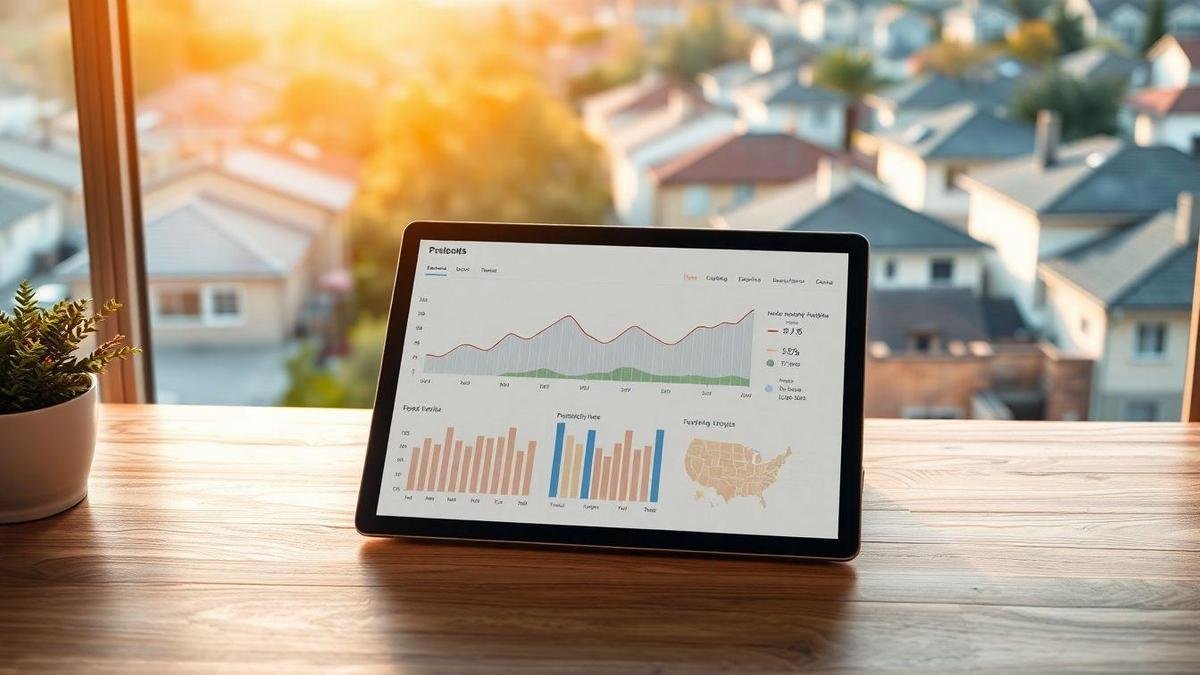Predictive analytics in real estate marketing gives agents a simple, powerful playbook. It shows how data sources, lead scoring, buyer intent, price forecasts, neighborhood trends, demand forecasts, personalized recommendations, attribution, and churn prediction fit together. The guide explains key metrics, common models, practical tools, and clear action steps when a high‑score lead appears — so teams leave ready to use data to win more listings and close more buyers. For a broader digital strategy, pair these techniques with a focused real estate digital marketing strategy.
- Use past data to spot homes buyers want.
- Target ads to the right people with lead scoring and buyer intent signals.
- Predict price moves with price forecasts to set competitive listings.
- Time outreach to when leads are ready.
- Test and refine campaigns to improve ROI and reduce churn. See methods to measure marketing ROI for real estate.

How Predictive analytics in real estate marketing works
Predictive analytics in real estate marketing acts like a weather forecast for the market: agents collect signals, feed them to models, and use the output to act faster and smarter. It predicts which leads will buy, which listings will sell fast, and where to spend ad dollars.
Data sources agents use for models
Agents pull signals from multiple places. Each source adds context about buyer interest and property value.
- Public records — sales history, tax records, deed transfers (show price trends and ownership).
- MLS — listing dates, status, features (show time on market, comps).
- CRM and lead data — contact dates, communications, lead source (show lead intent). Explore CRM options and best practices like those in the best CRM for land developers guide.
- Web analytics — pageviews, search terms, click paths (show which neighborhoods and features attract attention); combine with mobile‑first real estate tactics to capture on‑the‑go behavior.
- Demographic & socio‑economic data — income, household size, commute times (show who can afford and who may move).
- Third‑party data — mortgage rates, school ratings, walk scores (adds context to value and demand); compare property data tools in the PropStream vs LandGlide review.
Data source | What it shows | Example use
-
- –|—:|—
Public records | Past prices, ownership | Spot neighborhoods with rising sales
MLS | Active vs sold trends | Pick comps for pricing
CRM | Lead behavior | Score who to call first
Web analytics | Interest by page | Target ads to popular features
Demographics | Buyer profile | Match listings to audience
Third‑party | Market context | Adjust messaging for schools or transit
Common analytics methods and simple models
Agents favor simple, repeatable models that deliver fast answers.
- Linear regression — predicts price from features (size, beds).
- Logistic / classification — predicts if a lead will convert (hot/cold).
- Time‑series models — track price or demand over weeks (spot trends, seasonality).
- Clustering — groups similar buyers or properties (build ad audiences).
- Scoring rules — combine signals into a simple score (route top prospects).
Method | Simple explanation | Practical use
-
- –|—:|—
Regression | Maps features to price | Fast valuation for listings
Classification | Maps features to yes/no | Prioritize follow-up
Time‑series | Looks at data over time | Detect market shifts
Clustering | Groups similar items | Build ad audiences
Scoring | Sums weighted signals | Route leads to agents
Example: build a score from web visits number of calls past purchases. High score = call within 24 hours; low score = nurture by email.
Key metrics to track for campaign success
Track clear metrics that show whether analytics help sales.
- Lead conversion rate — leads → clients.
- Cost per lead (CPL) — ad spend ÷ leads.
- Time to close — days from lead to deal.
- Engagement rate — clicks, form fills, replies.
- Model accuracy — RMSE for price or percent correct for classification.
- Lift — improvement over baseline.
Metric | What it measures | Why it matters
-
- –|—:|—
Conversion rate | Leads → clients | Direct business result
CPL | Spend per lead | Budget control
Time to close | Speed of deal | Operational gain
Engagement | Interest level | Creative check
Model accuracy | Prediction quality | Trust in decisions
Lift | Relative gain | Value from analytics
Watch trends, not single days. If conversion rises while CPL falls, the model is working.

Lead scoring for realtors using predictive analytics in real estate marketing
How agents rank prospects with scores
Each prospect receives a lead score — a number showing likelihood to transact. Scores combine behavioral signals and historical data, weighting website visits, saved listings, and message replies. Higher score = higher priority.
Example: a lead views the same property three times and opens every email. The score rises; the agent calls within 15 minutes; a showing is booked — a warm lead becomes a client. That is the power of Predictive analytics in real estate marketing.
Score range | Meaning | Typical action
-
- –:|—|—
80–100 |
- –:|—|—
Hot lead | Call now. Schedule showing.
50–79 | Warm lead | Send matches. Follow up in 24–48 hrs.
20–49 | Cold lead | Add to nurture drip. Monitor behavior.
0–19 | Low interest | Re‑engage quarterly. Update profile.
Data points used for lead scoring
Common inputs and why they matter:
Data point | Why it matters | Example source
-
- –|—|—
Website visits | Shows active interest | Page views, repeat visits
Search behavior | Reveals property type/price | Saved searches, filters used
Email engagement | Measures timing & attention | Opens, clicks, replies
MLS activity | Market-specific interest | Saved listings, showings requested
Contact history | Shows responsiveness | Calls, texts, meetings
Demographics | Likely budget and needs | Age, family size, job location
Transaction history | Predicts readiness | Past purchases, sale dates
Loan/pre‑approval | Indicates buying power | Pre‑approval, mortgage queries
Social/ad clicks | Flags campaign-driven interest | Ad clicks, social engagement
Each input is weighed. The model learns which signals predict a sale and sharpens over time. For systems and integrations, consider CRM guidance such as the best CRM for land developers overview and the practical easy CRM setup guide.
Action steps when a high‑score lead appears
When a lead hits a high score, act fast:
- Call within 15 minutes. Timing wins meetings.
- Personalize the message. Mention the listing or saved search.
- Offer a same‑day showing. Book if possible.
- Prepare comps & financing options. Have a short packet ready.
- Assign follow-ups. Set reminders and responsibilities.
- Log outcomes. Update the CRM for next moves.
Quick follow-up and relevant info often turn scores into closings.

Buyer intent prediction to identify ready buyers
Signals that show buyer intent (site behavior)
Agents watch site behavior to find buyers ready to act. Common signals:
- Repeat visits to the same listing
- Long time on page and many page views
- Saved or favorited properties and saved searches
- Multiple map zooms or route checks
- Contact form submissions or click‑to‑call actions
- Download of floor plans or brochures
- Email opens and link clicks from alerts
Small actions stack into clear intent. Prompt outreach after such signals raises response rates and moves deals faster.
How Predictive analytics in real estate marketing improves conversion
Predictive models turn signals into a score, ranking leads by readiness so agents focus on those most likely to buy. Outcomes:
- Prioritize follow‑up by score.
- Suggest the best next action (call vs email).
- Time outreach to moments of high interest.
- Personalize listing suggestions.
Example: calling high‑intent leads within an hour led to more showings and a shorter sales cycle.
Tools that detect intent and how agents act
Tool type | What it detects | How the agent acts
-
- –|—|—
Web analytics (Google Analytics) | Page views, session length | Prioritize repeat visitors
Behavioral heatmaps (Hotjar) | Clicks, scroll depth | Refine listing pages
CRM with lead scoring (HubSpot, Salesforce) | Aggregated intent score | Call top‑scored leads first — see CRM integration tips in the CRM setup guide
Email tracking (Mailchimp, Yesware) | Opens, clicks | Send targeted messages after opens
Third‑party intent data (Bombora) | Market‑level interest | Target buyers researching neighborhoods; compare external data feeds in the property data tools comparison
Simple rules work: if lead score > 80, call within 1 hour; if downloaded floor plan, send parking/HOA details; if multiple map interactions, offer a showing.

Property price forecasting with predictive analytics real estate models
Factors used in property price forecasting
Models use many factors to estimate value:
- Location — zipcode, neighborhood, school ratings.
- Property features — beds, baths, size, age.
- Market signals — recent sale prices, days on market, inventory.
- Economic indicators — interest rates, employment, local income.
- Condition & upgrades — renovations, curb appeal.
- Temporal effects — season, month, year.
Factor group | Example inputs | Why it matters
-
- –|—|—
Location | School score, transit access | Drives demand and price levels
Property features | Sqft, bedrooms | Direct link to buyer needs
Market signals | Median sale, inventory | Shows supply and demand
Economic data | Mortgage rate, jobs | Affects buyer ability to pay
Condition | Recent remodels | Can add premium to price
Time | Month, year | Captures cycles & seasonality
A model is like a weather map: it shows where prices may rise or fall and helps set data‑backed listing prices. For deeper valuation workflows and investment checks, pair forecasts with a real estate feasibility report.
How forecasts help set accurate listing prices
Forecasts provide a range, not a single number, guiding pricing strategy:
- Set a competitive entry price to attract offers.
- Inform sellers about likely sale windows and price sensitivity.
- Align marketing with predicted buyer segments.
Example: a predicted 90–95% sale‑to‑list ratio helps choose an entry price that draws multiple offers.
Use cases | Benefit
-
- –|—
Setting list price | Faster sale, fewer price cuts
Marketing targeting | Better ad ROI, right buyers reached
Renovation decisions | Spend aligned to value impact
Negotiation prep | Clear counteroffer bands
- –|—
Limits and accuracy checks for price models
Models have limits: outdated data, local quirks, small samples, or market shocks can mislead. Core checks:
- Compare predictions to recent closed sales.
- Use holdout samples / cross‑validation.
- Track error metrics like MAPE.
- Flag outliers for human review.
- Update models often with fresh data.
Check | What it shows
-
- –|—
Out‑of‑sample test | Real‑world prediction power
Error tracking (MAPE) | Typical percent error
Residual plots | Bias or missing trends
Human audit | Local rules and exceptions caught
- –|—
Treat models like a compass: they point the way, but local knowledge guides the final path.

Neighborhood trend analysis to spot growth and value shifts
Local data sources for neighborhood trend analysis
Use local signals to read market shifts early:
- Public records — sales and ownership changes
- MLS — active listings, days on market, price drops
- Building permits — new construction or renovation
- Census & ACS — population, income, household size
- School ratings — family demand signals
- Transit & infrastructure plans — future access and value
- Crime statistics — safety perception
- Rental market listings — rent trends and yields
- Utility hookups — new connections indicate growth
- Social data & local reviews — sentiment and buzz
Source | What it shows | How an agent uses it
-
- –|—|—
Public records | Price history, transfers | Spot rising turnover
Building permits | New builds, remodels | Gauge supply changes
MLS | Listings, time on market | Track selling speed & pricing
Census/ACS | Demographics, income | Match property to buyer profiles
Transit plans | Planned stations, routes | Forecast access‑driven gains
For land and development opportunities, layer these signals with insights from land development trends and practical guides to marketing land in the US or how to sell land online.
How they map trends for buyers and investors
Turn raw data into maps and scores for insight:
- Create time‑series charts by block.
- Build heat maps for price per sqft and rental yield.
- Layer permits, school ratings, and transit on maps.
- Score micro‑markets for short‑term demand and long‑term growth.
Map type | Buyer insight | Investor insight
-
- –|—|—
Heat map (price/sqft) | Where prices fit budget | Where cap rates shift
Time‑series map | Neighborhood momentum | When to buy before appreciation
Permit overlay | Signs of upgrade | Predict supply changes
School overlay | Family pockets | Stable rental demand
- –|—|—
Example: surge in remodel permits near a new transit stop, matched to rising rents, helps predict which streets will gain value — a practical use of Predictive analytics in real estate marketing.
Visual tools agents use to show neighborhood trends
- GIS platforms — layered maps
- Dashboards (Tableau, Power BI) — snapshots & drill downs
- Heat maps — hot/cold spots
- Story maps — combine narrative, photos, and data
- Custom MLS reports — local detail
- Interactive web maps — remote exploration
Tool | Visual output | Typical use
-
- –|—|—
GIS | Layered maps | Combine permits, crime, transit
Tableau / Power BI | Dashboards | Track KPIs and trends by submarket
Heat map tools | Color‑coded maps | Show price or demand intensity
Story maps | Map narrative | Walk clients through neighborhood change
- –|—|—
Enhance listing visuals and neighborhood storytelling with professional imagery — consider adding drone photography to highlight context and curb appeal for buyers and investors.

Demand forecasting housing market to plan inventory and timing
Demand forecasting helps decide when to list, hold, or discount. Teams use Predictive analytics in real estate marketing to spot shifts before competitors, saving time and money.
Economic and seasonal inputs for demand forecasts
Core inputs that move buyers and sellers:
- Interest rates — change mortgage costs and buying power.
- Employment & wages — drive household formation.
- Consumer confidence — buyers act when confident.
- Housing supply — low supply pushes prices up.
- Seasonality — spring often sees more traffic.
- Local events — a new employer or school can boost demand.
Input | Why it matters | Typical data source
-
- –|—|—
Interest rates | Change monthly payment size | Central bank reports, lenders
Employment | Drives household formation | Local labor reports, census
Supply (inventory) | Tight supply raises competition | MLS, local listings
Seasonality | Changes buyer activity by month | Historical sales data
Consumer confidence | Affects buying decisions | Surveys, economic briefs
Example: a drop in local listings with flat interest rates signals stronger competition — list more aggressively.
How demand forecasting guides marketing calendars
Map forecast signals to marketing moves; the calendar becomes a playbook:
- When high demand, push listing launches, raise ad spend, hold open houses.
- When slow demand, focus on nurture, virtual tours, price testing.
- Before seasonal peaks, schedule staging and premium photography early.
- After new employer announcements, target relocating buyers.
Forecast signal | Marketing action | Timing
-
- –|—|—
Rising demand | Increase paid ads; book opens | Immediate (1–2 weeks)
Falling demand | Start nurture drip; add virtual tours | 2–4 weeks
Seasonal upswing | Schedule staging & pro photos | 3–6 weeks before peak
Local employer growth | Geo‑targeted campaigns | 1–2 months after announcement
Ways agents adjust listings based on demand signals
- Price adjustments — raise or trim to match buyer pressure.
- Listing timing — delay or accelerate launches.
- Staging focus — invest more in hot markets.
- Photography & video — upgrade visuals when traffic is high.
- Open house scheduling — add nights/weekends when visits spike.
- Incentives — credits or closing help in slow periods.
- Ad spend reallocation — shift budget to high‑intent channels.
- Contract terms — shorten contingencies in seller’s markets.
Small timing and presentation changes often boost interest before price moves.

Personalized property recommendations to boost engagement
How profiles and behavior create better matches
Build a profile (age, budget, location, type) and track behavior (pages viewed, filters, time spent, saved listings). Together they guide recommendations.
Profile attribute | Behavioral signal | Resulting match
-
- –|—|—
Budget range | Viewed within price band | Recommend similar-priced homes
Family status | Searched for schools, parks | Highlight family-friendly areas
Commuter | Filtered by commute time | Show properties near transit
Investment focus | Revisited rental pages | Surface multi-unit / high-yield options
- –|—|—
Example: a client clicked three 2‑bedrooms near transit; the system nudged similar options and the client replied the next day — a quick win from small signals and Predictive analytics in real estate marketing.
Email and site personalization with predictive analytics in real estate marketing
Personalize subject lines, hero images, and listing rank. Use Predictive analytics in real estate marketing to rank listings by fit and urgency, show a custom feed, and send emails timed to user habits. Incorporate mobile optimization to ensure those personalized feeds perform well on phones, following mobile‑first best practices.
Tactics that work:
- Dynamic subject lines with a key feature.
- Homepage feed ordered by predicted interest.
- Follow‑up emails triggered by drop‑offs (viewed but not saved).
Personalization element | What it changes | Expected effect
-
- –|—|—
Ranked listing feed | Order of items shown | Higher engagement
Behavior‑triggered email | Sends after specific actions | Faster responses
Dynamic imagery | Matches style preferences | Stronger click appeal
- –|—|—
Measure lift with short A/B tests, tracking CTR, lift, conversion rate, and time‑to‑inquiry.
Metric | Formula | Why it matters
-
- –|—|—
CTR | clicks / impressions | Immediate interest
Lift | (CTRvariant − CTRcontrol) / CTR_control | Improvement from recommendations
Conversion rate | inquiries / clicks | Do clicks become leads?
Time‑to‑inquiry | avg time from click to contact | Reveals friction points

Marketing attribution in real estate to prove channel impact
Attribution models and their tradeoffs
Attribution assigns credit across channels. Choose a model to match goals.
Model | What it does | Pros | Cons
-
- –|—|—|—
Last‑click | Credits last touch | Simple, easy | Misses early influence
First‑click | Credits first touch | Shows origin | Ignores closing touches
Linear | Splits evenly | Fair across steps | Overvalues small interactions
Time‑decay | More credit to recent touches | Values recent nurture | Undervalues early branding
Position‑based | Mix of first & last | Balances start & close | Still arbitrary
Algorithmic / Multi‑touch | Uses data to weight touches | Closest to reality if data‑rich | Needs clean data & setup
A last‑click view might cut social ad spend even if social created awareness weeks earlier.
How they tie leads to ad spend and ROI
Track clicks with UTM tags or ad IDs, store interactions in the CRM, match closed deals to touchpoints, and divide revenue per the chosen model. Combine attribution with predictive lead scores to shift budget toward channels that bring higher‑value leads, not just more leads. For guidance on evaluating investment returns for campaigns and projects, consult the marketing ROI resources and, for land projects, the ROI for land development analysis.
Key metrics: CPL, CPA, Conversion Rate, Lead Quality Score, LTV, ROAS, Incrementality.
Metric | Why it matters | How to act
-
- –|—|—
CPL | Shows efficiency | Cut / optimize high CPL channels
Conversion Rate | Funnel health | Improve landing pages or follow‑up
LTV | Long‑term value | Invest in channels that bring higher LTV
ROAS | Quick economic snapshot | Reallocate to high ROAS channels
Incrementality | Proves real impact | Run controlled tests before scaling
Good reports mix these metrics and answer: did this spend create real value or just clicks?

Churn prediction: property management to cut tenant loss
Signals that predict churn and early interventions
Watch tenant behavior for red flags: late payments, fewer maintenance requests, or declining communication. Early interventions save vacancy costs.
Signal | Why it matters | Early intervention
-
- –|—|—
Late rent | Financial pressure | Offer flexible payment plan
Fewer service calls | May indicate plans to leave | Proactive satisfaction check
Declining renewals | Direct churn risk | Offer incentives to renew
Models flag at‑risk tenants so teams can act early. A phone call or a simple plan often prevents vacancy.
Risk assessment for investment properties
Score properties to identify vacancy, maintenance, and financial risk using rent trends, turnover, maintenance history, and neighborhood data.
Risk type | Inputs | Predicts
-
- –|—|—
Vacancy risk | Turnover rate, demand | Likely future vacancies
Maintenance risk | Repair history, system age | Costly failures soon
Financial risk | Rent trend, payment records | Revenue shortfalls
Investors use scores to decide which buildings to buy or fix first, avoiding costly mistakes; check investment tools and developer workflows in the tools for developers guide.
Cost savings from reducing churn and managing risk
Vacant units cost months of lost rent plus cleaning, repairs, and advertising. Predictive actions reduce these losses.
Cost item | Typical cost per vacancy | Savings with predictive action
-
- –|—:|—:
Lost rent (2 months) | $2,000 | $2,000 avoided
Cleaning & repairs | $300 | $300 avoided
Advertising & leasing | $500 | $500 avoided
- –|—:|—:
Total | $2,800 | $2,800 saved per avoided vacancy
A portfolio that cuts vacancy by 30% can pay for analytics tools within months.
How to implement Predictive analytics in real estate marketing (practical steps)
- Inventory your data sources (MLS, CRM, web analytics, public records, third‑party) — include property feeds such as those compared in PropStream vs LandGlide.
- Define clear use cases (lead scoring, price forecasting, churn prediction).
- Start small: implement one model (lead score or price estimate) and measure impact.
- Integrate scores into workflows (CRM alerts, task routing, ad targeting) — refer to the CRM setup guide for integration tips.
- Run A/B tests and track CPL, conversion, time to close, and lift.
- Iterate: refine signals, retrain models, and add use cases as data improves.
For land and development teams, layer these steps with planning insights from feasibility reports and land development trends to align forecasting with project timelines.
Implementing Predictive analytics in real estate marketing is iterative: start with one clear problem, measure, then scale.
In the End…
Predictive analytics in real estate marketing is a practical playbook — part weather map, part compass — that turns layered data sources into clear signals. Use lead scoring, buyer intent, and personalized recommendations to call the right people at the right time. Rely on price forecasts, neighborhood trends, and demand forecasting to set competitive listings and time launches. Tie activity to attribution and ROI to prove which channels move the needle. Small, fast actions — a 15‑minute call, a tailored email, an informed price tweak — compound into measurable gains and lower churn. Explore more practical guides and tools at RealHubly insights.
Eduardo Bugallo, PhD.

4 Responses
[…] Predictive Analytics In Real Estate: The Future Of Marketing In 2025 on Land Development Trends 2025: Surprising Shifts Investors Can’t IgnoreAugust 29, 2025 […]
[…] Real Estate Lead Generation Tools: The Game-Changers Of 2025 on Predictive Analytics in Real Estate: The Future of Marketing in 2025August 29, […]
[…] Real Estate Lead Generation Tools: The Game-Changers Of 2025 on Predictive Analytics in Real Estate: The Future of Marketing in 2025August 29, […]
[…] Estate Website Optimization For Leads Now on Predictive Analytics in Real Estate: The Future of Marketing in 2025September 8, […]